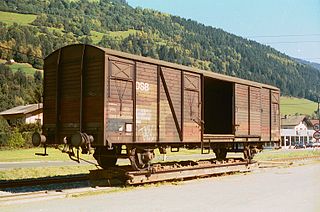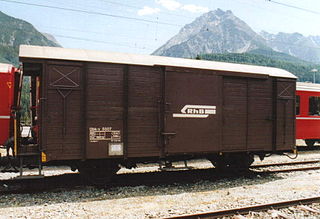Related Research Articles

Containerization is a system of intermodal freight transport using intermodal containers. Containerization, also referred as container stuffing or container loading, is the process of unitization of cargoes in exports. Containerization is the predominant form of unitization of export cargoes, as opposed to other systems such as the barge system or palletization. The containers have standardized dimensions. They can be loaded and unloaded, stacked, transported efficiently over long distances, and transferred from one mode of transport to another—container ships, rail transport flatcars, and semi-trailer trucks—without being opened. The handling system is mechanized so that all handling is done with cranes and special forklift trucks. All containers are numbered and tracked using computerized systems.

The Great Western Railway (GWR) was a British railway company that linked London with the southwest, west and West Midlands of England and most of Wales. It was founded in 1833, received its enabling Act of Parliament on 31 August 1835 and ran its first trains in 1838 with the initial route completed between London and Bristol in 1841. It was engineered by Isambard Kingdom Brunel, who chose a broad gauge of 7 ft —later slightly widened to 7 ft 1⁄4 in —but, from 1854, a series of amalgamations saw it also operate 4 ft 8+1⁄2 in standard-gauge trains; the last broad-gauge services were operated in 1892.

A railroad car, railcar, railway wagon, railway carriage, railway truck, railwagon, railcarriage or railtruck, also called a train car, train wagon, train carriage or train truck, is a vehicle used for the carrying of cargo or passengers on a rail transport network. Such cars, when coupled together and hauled by one or more locomotives, form a train. Alternatively, some passenger cars are self-propelled in which case they may be either single railcars or make up multiple units.

The Narrow Gauge Railway Museum is a purpose-built museum dedicated to narrow-gauge railways situated at the Tywyn Wharf station of the Talyllyn Railway in Tywyn, Gwynedd, Wales.

A transporter wagon, in railway terminology, is a wagon (UIC) or railroad car (US) designed to carry other railway equipment. Normally, it is used to transport equipment of a different rail gauge. In most cases, a transporter wagon is a narrower gauge wagon for transporting a wider gauge equipment, allowing freight in a wider gauge wagons to reach destinations on the narrower gauge network without the expense and time of transshipment into a narrower gauge wagons.

With railways, a break of gauge occurs where a line of one track gauge meets a line of a different gauge. Trains and rolling stock generally cannot run through without some form of conversion between gauges, leading to passengers having to change trains and freight requiring transloading or transshipping; this can add delays, costs, and inconvenience to travel on such a route.

Rail freight transport is the use of railroads and trains to transport cargo as opposed to human passengers.

The Eaton Hall Railway was an early 15 in gauge minimum gauge estate railway built in 1896 at Eaton Hall in Cheshire. The line, which connected the Grosvenor estate with sidings at Balderton on the GWR Shrewsbury to Chester Line about 3 miles (4.8 km) away, opened in 1896. It was built for the Duke of Westminster by Sir Arthur Percival Heywood, who had pioneered the use of 15 in gauge with his Duffield Bank Railway at his house at Duffield, Derbyshire in 1874.

Great Western Railway telegraphic codes were a commercial telegraph code used to shorten the telegraphic messages sent between the stations and offices of the railway.

Flat wagons, as classified by the International Union of Railways (UIC), are railway goods wagons that have a flat, usually full-length, deck and little or no superstructure. By contrast, open wagons have high side and end walls and covered goods wagons have a fixed roof and sides. Flat wagons are often designed for the transportation of goods that are not weather-sensitive. Some flat wagons are able to be covered completely by tarpaulins or hoods and are therefore suitable for the transport of weather-sensitive goods. Unlike a "goods wagon with opening roof", the loading area of a flat is entirely open and accessible once the cover is removed.

General Establishment of Syrian Railways is the national railway operator for the state of Syria, subordinate to the Ministry of Transportation. It was established in 1956 and was headquartered in Aleppo. Syria's rail infrastructure has been severely compromised as a result of the ongoing conflict in the country.

A covered goods wagon or van is a railway goods wagon which is designed for the transportation of moisture-susceptible goods and therefore fully enclosed by sides and a fixed roof. They are often referred to simply as covered wagons, and this is the term used by the International Union of Railways (UIC). Since the introduction of the international classification for goods wagons by the UIC in the 1960s a distinction has been drawn between ordinary and special covered wagons. Other types of wagon, such as refrigerated vans and goods wagons with opening roofs, are closely related to covered wagons from a design point of view. Similar freight cars in North America are called boxcars.

Baulk road is the name given to a type of railway track or 'rail road' that is formed using rails carried on continuous timber bearings, as opposed to the more familiar 'cross-sleeper' track that uses closely spaced sleepers or ties to give intermittent support to stronger rails.

The fleet of Great Western Railway wagons was both large and varied as it carried the wide variety of goods traffic on the Great Western Railway (GWR) in the United Kingdom. This was the railway company that operated for the longest period of time in the country and covered a large geographical area that included big cities such as London, industrialised areas including the West Midlands, areas of coal and mineral mining such as South Wales, and Somerset and other important agricultural districts. In 1902 the company owned 59,036 wagons, and by 1926 this had risen to 88,580.

The Tetbury branch line was a 7.5-mile (12.1 km) single-track branch railway line that connected Tetbury with the main line at Kemble on the line between Swindon and Gloucester.
The GWR 633 Class were 0-6-0Ts designed by George Armstrong and built at the Wolverhampton railway works of the Great Western Railway between November 1871 and April 1872. These were always Southern Division locomotives, but over the years some were fitted to work the Metropolitan lines and played a large role in the transportation of goods from Acton to Smithfield. Unusually, they had side tanks, and inside frames, with wheels of 4 ft 6+1⁄2 in (1,384 mm) in diameter and a wheelbase of 15 ft 6 in (4.72 m). Their weight was 34 long tons 12 cwt. There were twelve locomotives, numbered 633–644.

The GWR Toad is a class of railway brake van, designed by and built for the Great Western Railway. Used by the GWR from 1894, and post-1947 by the Western Region of British Railways, its role was a safety brake on goods trains in the West of England, the Midlands and Wales.

The GWR Siphon was a series of enclosed milk churn transport wagons built by the Great Western Railway and continued by British Railways.

Milk tank wagons were a common sight on railways in the United Kingdom from the early 1930s to the late 1960s. Introduced to transport raw milk from remote dairy farms to central creameries, milk trains were the last railway-based system before the move to road transport.

Milk trains were a common sight on the railways of Great Britain from the early 1930s to the late 1960s. Introduced to transport drinking milk from creameries to consumers in the cities, by 1981 they had all been replaced by road transport.
References
- ↑ Russell 1983, pp. 201–203.
- ↑ Atkins et al. 1976, p. 36.
- ↑ Russell 1983, p. 203.
- ↑ Atkins et al. 1975, p. 38.
- ↑ Atkins et al. 1976, pp. 35–36.
- ↑ SydneyMorningHerald1930.